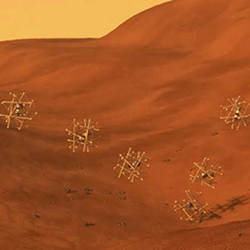
Landing a rover on another planet requires a lot of equipment: an explorer needs something that will cushion its landing, a container to hold the rover, and wheels and motors to move the scientific instruments around on the planet’s surface. A pair of researchers at the U.S. National Aeronautics and Space Administration (NASA) believe they can simplify the process by replacing much of that equipment with a contraption made of rods and cables.
The device, called the Super Ball Bot, would absorb the impact of the landing, removing the need for an airbag that would just be discarded. Once on the surface, it would transport the instruments where they needed to go, replacing the separate rover module, as well as protecting them from further impacts. That would both reduce the mass, and therefore the fuel, a spacecraft needs to carry—always a concern for launching anything into orbit or beyond—and make the mission more robust.
"Maybe you can get away with something that is pretty tough at landing and you don’t need all these extraneous airbags and stuff," says Adrian Agogino, a software engineer at NASA Ames Research Center in Mountain View, CA. He and Vytas SunSpiral, a robotics researcher at Ames, described their concept at the February meeting of NASA Innovative Advanced Concepts (NIAC), the program funding the work.
The robot is based on the concept of "tensegrity," developed by R. Buckminster Fuller as a combination of tension and integrity. It consists of a series of rods connected by cables that act like a spring, deforming to absorb an impact. Motors in the ends of the rods can tighten or loosen the cables to make the structure move. The initial device consists of six rods, each 1.5 meters long, which Agogino says is the minimum required to make a ball-like shape; adding more rods can make the motion smoother, and making a larger structure provides both greater shock absorption and more volume to hold the instrument.
In fact, the structure can scale up to larger sizes much more easily than an airbag, SunSpiral said, thereby enabling larger landers. It also has advantages in mobility. Current rovers move very slowly, for fear of hitting something, and if they encounter an obstacle, they must stop and wait for instructions from Mission Control. Controllers also like to keep their landers away from cliff edges and rock walls, to avoid destroying their delicate equipment. That’s not a problem with a tensegrity robot, with its built-in shock absorber. "If it falls into a ditch, maybe it’s not preferable, but it can be okay," Agogino says. "If it bumps into a rock, it can be okay."
On the other hand, figuring out how to control the robot’s motion was not easy. Agogino programmed the robot’s motors with 70 different parameters and let it choose among them randomly, resulting in a lot of jerky motion but no forward progress. "It looks like you electrocuted a cockroach," he says. Some of the random motions were a little more useful than others, so he used machine learning to recognize the best set of parameters and ran them again, repeating the process until he had evolved a set of instructions that caused the robot to head toward a target. The result is a control scheme that will allow mission controllers to select a target and then let the robot move itself there; delays in radio signals over interplanetary distances mean earthbound controllers can’t steer it themselves.
The mission the pair has in mind is a hypothetical landing on Titan, one of Saturn’s moons, though NASA doesn’t currently have such a mission scheduled. Titan’s atmosphere is much thicker than Earth’s, but its gravity is much lower, so dropping a probe from orbit would be the equivalent of dropping it off a three-story building on Earth, which the robot can easily handle. On a celestial body with a different combination of atmosphere and gravity, the lander might require a parachute or retro-rocket to slow it down, but the structure would still provide the same advantages over an airbag, Agogino says. On an airless asteroid or moon with very low gravity where wheels wouldn’t get much traction, the robot could bounce along the surface.
The robot might also prove useful here on Earth. Because it is more robust and mobile than wheeled vehicles in certain terrains, it could carry equipment for soldiers, or be dropped from a drone to survey an area. It might be loaded with sensors and dropped into a forest fire to assess the situation on the ground. It could be a good way of allowing robots to provide services to the elderly, in their homes, or a nursing facility, because it would essentially be soft and less apt to harm a person than a rigidly structured automaton. "A robot that doesn’t get hurt and doesn’t hurt people has many earthbound uses," Agogino says.
He and SunSpiral built a prototype Super Ball Bot with a $100,000 grant from NIAC; now they have a $500,000 Phase 2 grant to build a more complex prototype. The aim is merely to learn how to build and control such a robot; NIAC only funds ideas that couldn’t be realized for a decade or more. Specific decisions about size, power source, and other factors would be made if the tensegrity robot were ever chosen for an actual mission.
Neil Savage is a science and technology writer based in Lowell, MA.



Join the Discussion (0)
Become a Member or Sign In to Post a Comment